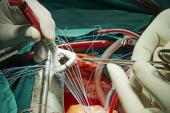FDA Alert: Possible Early Deterioration of Abbott Trifecta SAVR Valves
Some evidence suggests early structural valve deterioration is more common with these valves than others on the market.

There is potentially a higher risk of early structural valve deterioration (SVD)—within 5 years—with Abbott’s Trifecta valves than with other comparable SAVR bioprostheses, according to an alert issued today by the US Food and Drug Administration.
The agency said there are published data showing a higher incidence of early SVD and lower freedom from reintervention due to SVD for the Abbott devices—which include the first-generation Trifecta Valve approved in 2011 (no longer marketed in the US) and the next-generation Trifecta Valve with Glide Technology (Trifecta GT) approved in 2016.
No specific studies were cited, but a meta-analysis published last month in General Thoracic and Cardiovascular Surgery showed that externally mounted valves, including Trifecta and the Mitroflow (LivaNova), carried higher risks of reoperation for SVD and all-cause mortality compared with bioprostheses with an internally mounted design.
The FDA said it also has received medical device reports (MDRs) related to the issue. “Reported outcomes include surgical valve explant/replacement, transcatheter valve-in-valve intervention, and in some cases death,” the alert reads. “The FDA recognizes the limitations of MDR data, including that incidence cannot be determined from the passive surveillance reporting system.”
Users of the Trifecta valves should be aware of the potential for early SVD and also the management considerations provided today by Abbott, the agency advised. In addition, it says, surgeons should follow the instructions for use carefully and discuss the risks and benefits of all available options with patients.
After surgery, patients should be monitored for signs and symptoms of potential SVD and advised to seek medical attention if new symptoms like shortness of breath or fatigue develop. Lifelong follow-up is needed and should include at least yearly visits with assessment of the valve by transthoracic echocardiography starting a year after implantation, the FDA said.
The agency plans on keeping an eye on the issue moving forward, saying that it’s working with Abbott to evaluate information from all available sources to assess the risk of early SVD and to make new management recommendations as needed.
Todd Neale is the Associate News Editor for TCTMD and a Senior Medical Journalist. He got his start in journalism at …
Read Full BioSources
US Food and Drug Administration. Abbott Trifecta valves: potential risk of early structural valve deterioration – letter to health care providers. Published and Accessed on: February 27, 2023.





Comments